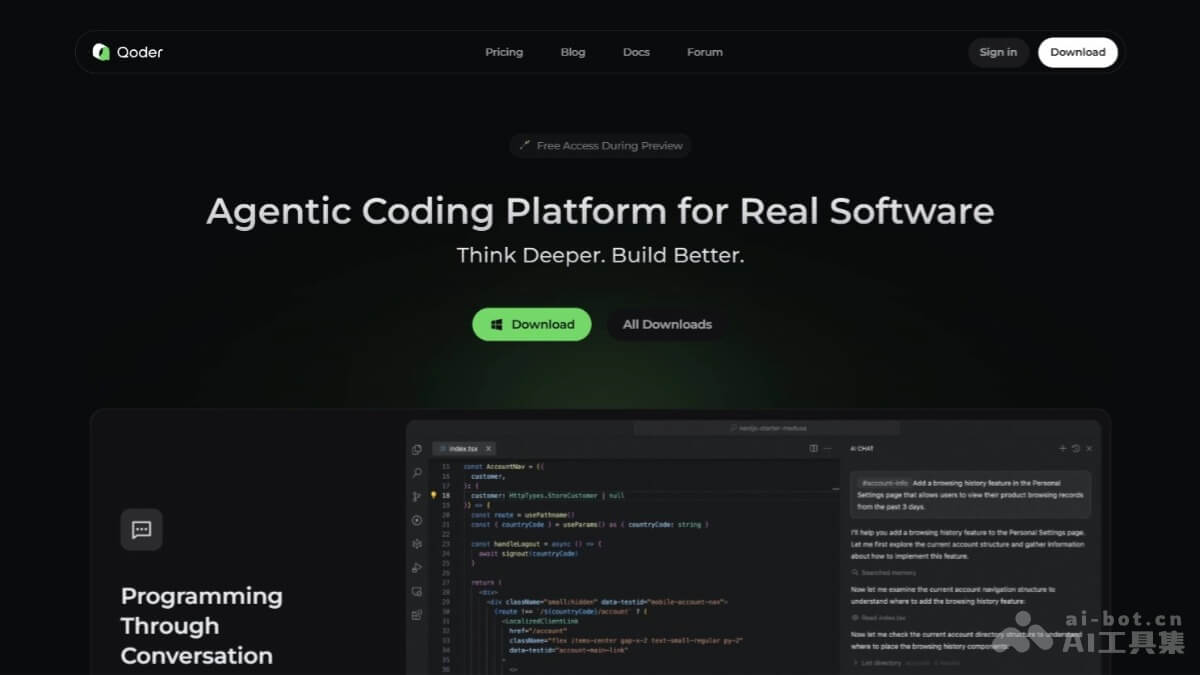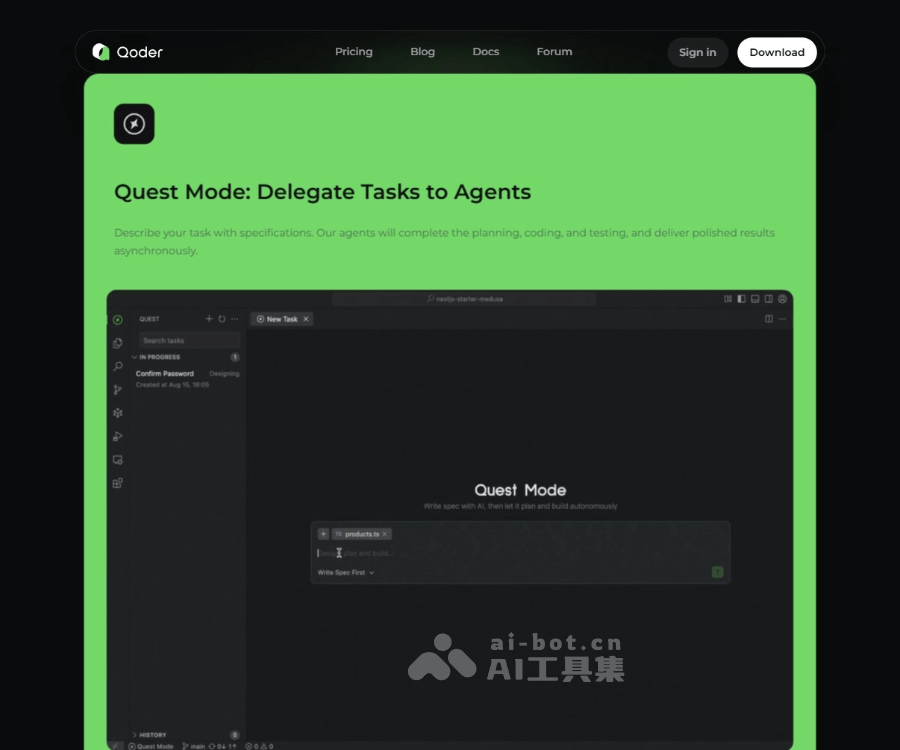What's Qoder?
Qoder is an AI Agent programming platform launched by Alibaba, which can deeply understand the whole code base and continuously memorize developer habits, support natural language search, asynchronous Quest agent tasks, automatic model routing and MCP tool extension.Qoder is more than just complementary code, more like a senior colleague, it can automatically generate architectural documents, batch refactoring, upgrading dependencies and mentioning PRs, preview period All features are free.

Qoder's core functionality features
"Panoramic Understanding, Continuous Memory, Asynchronous Agents, Zero-Decision Model Routing, Plug-and-Play Ecology"
- Millisecond indexing of the full repository, generating dependency graphs, architecture mapping & one-click wikification documentation.
- Project-level + session-level dual-layer memory, synchronized team norms, personal style, the more you use it, the more it understands you.
- Quest Mode writes long tasks like upgrading dependencies, refactoring across repositories, running tests, and raising PRs into a single sentence that can be done asynchronously in the background.
- Automatically picks the best large model based on language, task complexity, and cost in real time without manual switching.
- Instant access to databases, APIs, Docker, browsers and other tools through the MCP protocol, realizing one-stop reading, writing, debugging and deployment.
Qoder official website address
- Qoder official website address: https://qoder.com/
- Qoder download address: https://qoder.com/download
How to use Qoder
- Download and install from the official website (Win/Mac) → Sign in and authorize the repository with GitHub/GitLab/Google.
- The first time you start up, tap "Open Folder" to select an item and automatically index the full code base.
- Daily development: Tab within the editor to get context-aware completions, or select Code → Inline Chat to interpret/refactor/generate single tests.
- Batch task: Sidebar → Quest → Describe in natural language (e.g. "Upgrade all usages of Axios to latest and open a PR") → Submit, AI backend performs completion notification.
- Curing specification: Ctrl+Shift+P → "Qoder: Open Memory Rules" Write JSON rules → Share link to the team for one-click synchronization.
Qoder's Core Strengths and Points of Differentiation
Qoder's "Core Advantage" can be condensed into 6 sentences, each of which directly corresponds to an essential difference from traditional tools:
- Panoramic Context vs Localized Segments: milliseconds to read the entire repository, images, logs, and history commits into context at once, where traditional tools only look at a few dozen lines near the cursor.
- Growing Memories vs Reboot to Zero: Project-level + session-level dual-layer memory, continuous accumulation of personal style, team specification, change computer, change project second synchronization; traditional plug-ins each time you restart that is out of memory.
- Asynchronous Quest Proxy vs Synchronous CompletionAI can write a complex task "across hours and warehouses" into one sentence and throw it to the background, AI can complete it independently and provide PR; traditional tools can only accompany the chat in real time and complete the task line by line.
- Zero Decision Model Routing vs Manual Model Selection: automatically pick the optimal LLM based on language, task complexity, and cost, so developers don't need to study the GPT-3.5/4 difference; traditional solutions require people to switch over and over again.
- MCP Plug and Play vs. slow update of plugin marketThe IDE plug-ins are developed, audited and published separately.
- Inline Full Function vs Window Jumping: Refactoring, single testing, performance profiling, and patch application are all done within the editor, keeping the heart flow; traditional processes have to cut terminals, run scripts, and jump web pages.
Who Qoder is for
- Engineers maintaining large/legacy systems: Read millions of lines of code in seconds, automatically generate documentation and architecture diagrams.
- Technical Leader & Architect: To bulk upgrade dependencies, govern structural decay, and harmonize team norms.
- Full-stack/multilingual developer: Automatically slicing models and ensuring consistent interfaces in hybrid repositories such as Go + TS + Python.
- DevOps & Security Engineer: You want to automate CI runs, generate single tests, audit CVEs, and raise PRs with Quest.
- Startup & Remote Teams: Zero-configuration synchronized memory and specification to get new members up to speed on projects in 5 minutes.
Relevant Navigation
AI code review tool that reviews code line by line

CodeBuddy IDE
Tencent launches AI IDE that integrates production, design, and research

Genie
Cosine AI Launches AI Intelligent Development Assistant

Qodo
AI development platform, formerly CodiumAI

Wenshin Express
Baidu launches AI programming assistant

Mocha
AI zero-code application building platform with real-time view of application results

treasure chest
Making the creation of AI apps as easy as breathing

NoCode
Zero-code AI development platform launched by Mission

No comments...

